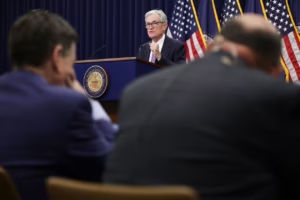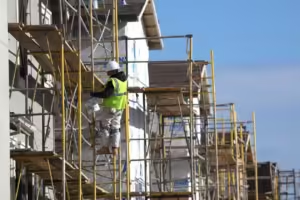Although the U.S. economy isn’t officially in a recession, a careful examination of regional economies suggests that the country may be on the verge of one as we approach Memorial Day weekend.
According to the Federal Reserve’s most recent analysis of the country’s economy, growth in three of the bank’s twelve districts was unchanged in April, while growth in four of them was falling. It was slow, and only five reported growth.
In the meantime, key regional industries were struggling along with little impetus, according to economists, local business leaders, and other experts from across the nation. They claim that they are having trouble understanding Washington’s policies.
Distress related to trade is evident everywhere.
Businesses and people across are feeling the burden of unforeseen consequences from continued U.S. trade battles as we approach Memorial Day weekend, which usually marks the beginning of a season of spending on items like travel.
Yellowstone National Park and New York City are preparing for a decline in foreign visitors. Cross-border commerce flows that were once a way of life are being interrupted in states like Texas and Michigan. Falling oil prices have hit hard, threatening jobs along the Gulf Coast’s Energy Belt. West Virginia is also concerned that the crossfire may affect its coal exports.
Indeed, as summer draws near, the economy appears to be continuing to expand. Some of the financial market tension that had affected Main Street 401(k) plans has been alleviated by the Trump administration’s temporary lowering of hefty tariffs on China and other nations to facilitate discussions.
Compared to a few weeks ago, Wall Street experts have lowered their predictions of a recession. Even though the odds are not “code red,” they are obviously not back to “all clear.”
If it hasn’t already, Washington, D.C., appears to be on the verge of going into a recession.
According to Yesim Sayin, executive director of the D.C. Policy Center, an independent research organization that focuses on the local economy, “it is difficult to see any bright spots when you look at the overall economic picture.”
Once believed to be recession-proof, the city is now significantly slowing down as a result of massive government employment losses implemented by the Trump White House.
“The term “recession” is both accurate and inaccurate. In the sense that the GDP of the region is declining, it is a recession,” Sayin stated.
She went on to say that the local economy is being negatively impacted by the federal government.
However, the city is not suffering greatly because a large number of its citizens continue to have well-paying occupations. Many restaurants and companies are closing, but there aren’t any abrupt halts, she said.
In other areas, all of the hope that small firms, in particular, had after Donald Trump retook office in January has vanished since the president initiated the largest trade war since the 1930s.
Furthermore, it’s not just the tariffs. It’s all the ambiguity brought about by abrupt changes in the White House’s strategy.
In the last few months, the administration has altered its tariff stance more than fifty times, leaving consumers and companies uncertain about what lies next.
As a result, Americans have reduced their spending, businesses have grown reluctant to invest, and hiring has slowed.
According to Ray Perryman, CEO of the Waco, Texas-based Perryman Group economic analysis firm, “the natural reaction to uncertainty is to do nothing.”
Price increases and empty shelves
Distress related to trade is evident everywhere.
To begin with, as shippers struggle with increased tariffs, ports from the East Coast to the West Coast have seen a decline in trade.
For example, the Port of Oakland, California, recorded a 15% decrease in imports in April. Similar decreases have been recorded by other major ports.
In the upcoming month or two, the brief decline in trade may cause sporadic shortages on store shelves. Experts warned that American consumers would not find everything they need.
Additionally, because tariffs are still significantly higher than they were prior to the trade war, even after the Trump administration rolled back some of them, prices for consumer necessities may increase.
According to Jeff Hornstein, executive director of the Economy League of Greater Philadelphia, “We are the country’s gateway for fruit.” “Most of the fruit on the East Coast comes through the port of Philadelphia and tariffs are going to affect that over time.”
In turn, the cumulative effect of price rises linked to tariffs is probably going to push U.S. inflation upward, at least momentarily.
Prior to the commencement of the trade war, the Federal Reserve was not far from its target of bringing the rate of U.S. inflation down to 2%.
Economists now forecast that inflation will gradually increase from the current rate of 2.3% to maybe reach 3% by the end of the year.
Jeffrey Korzenik, chief economist at Fifth Third Bank, stated, “We haven’t yet felt the impact of inflation, but we are over the worst of the [trade] fights.” Inflation, he predicts, will “settle above the Fed’s 2% goal.”
There are issues with even a slight increase in inflation. Most significantly, the Fed may not be able to lower interest rates and stimulate the faltering American economy. Additionally, customers will have less money for discretionary purchasing after receiving their paychecks.
The tourism sector is probably going to suffer.
It’s not just the flow of goods from overseas that has slowed. It is anticipated that fewer visitors from Mexico, Canada, China, and other nations will come to the United States this year.
Hornstein of the Philadelphia-based Economy League stated, “Tourism and leisure are now everyone’s problem.”
For instance, a large number of Chinese tourists have visited the well-known Yellowstone Park in recent years, to the point where many business owners have posted signs in Mandarin to draw in customers.
According to Megan Lawson of Headwaters Economics, an independent nonprofit organization focused on community development in Bozeman, Mont., “people aren’t sure if Chinese tourists are going to be able to visit,”
“Tourism is essential to rural Western communities,” Lawson said, adding that it contributes significantly to the economy, particularly for villages bordering federal lands.
The Big Apple is likely to be negatively impacted by the trade war as well.
Despite anticipating record numbers of visitors this year, the city’s tourism department now projects that 400,000 fewer people will visit New York City in 2024.
The concerns are not limited to this year; they also extend to 2026. Before the trade war broke out, Hornstein said, Philadelphia was counting on big numbers for the World Cup in the United States.
In any event, fewer visitors translate into lower spending. As a result, Americans will have fewer jobs at retail establishments, restaurants, hotels, and other establishments.
“These are closely tied to tourism,” said Cole Rakow, associate director for economics at the Independent Budget Office for New York City, which is nonpartisan.
According to a recent IBO research, the amount of net new employment produced in New York City in 2025—that is, hiring less layoffs—is probably going to drop from 119,000 the year before to just 32,000.
Excluding the pandemic, the United States may add the fewest employment in 15 years in 2025 if the hiring slowdown in New York City is repeated nationwide.
And the harm doesn’t end there.
Tax income will also be lower than government officials had anticipated as a result of reduced hiring and spending. States and towns will have to make more compromises as budgets become increasingly constrained.
States near borders are especially at risk.
Not all states will be equally affected. According to analysts, border states and those with stronger links to the global economy are most vulnerable to significant disruptions.
Consider the economy of Texas, which is strongly linked to that of northern Mexico.
According to Perryman of the Perryman Group, “it is not at all uncommon for products such as electronics and automobiles to cross the border multiple times during the manufacturing process,”
He claimed that despite the Lone Star State’s continued growth, businesses have been unable to make decisions because of the constant fluctuations in tariff rates.
States with sizable auto industries and strong ties to Canada, like Michigan and Ohio, experience similar stress as they attempt to adjust to sudden changes in trade regulations.
Auto sales may suffer if the price of purchasing a new automobile, which is now close to a record high, rises considerably further.
Crackdowns on immigration could hurt some areas.
There are other Trump administration policies that are giving businesses trouble than tariffs. The immigration crackdown may make matters worse.
Unauthorized immigrants made up 7% of the U.S. workforce, according to a recent report by the independent nonprofit research center Burning Glass Institute, which specializes in labor research.
These laborers are crucial to the economies of several large states, such red Texas, where 10% of workers are undocumented immigrants, and blue California, where 12% of the workforce is made up of undocumented immigrants.
Economists argue that regardless of the benefits of tougher immigration laws, they may create labor shortages in important sectors like construction and agriculture and may increase the cost of housing and food, which are two of the largest family expenses.
A settlement of the trade disputes, preferably prior to the expiration of temporary tariff reductions, would be extremely beneficial to the economy.
As long as the trade war ends, most businesses could manage the new taxes without too much trouble, even if the White House were to slap, say, 10% tariffs on other nations.





